Kingdom Animalia Subphylum Chelicerata Infraorder Araneomorphae Scientific name Phoneutria Rank Genus | Phylum Arthropoda Order Araneae Family Ctenidae Higher classification Wandering spider | |
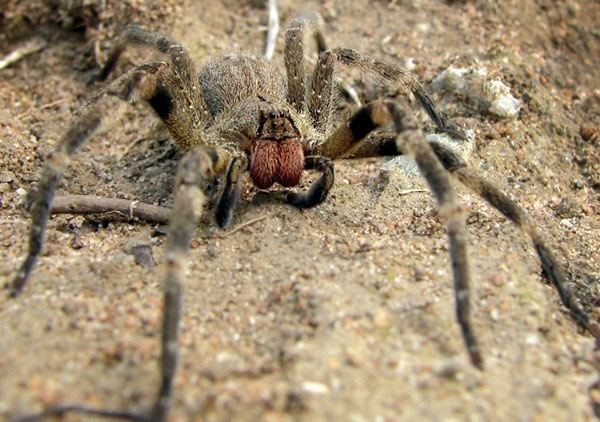 | ||
Lower classifications Phoneutria nigriventer, Phoneutria fera | ||
Phoneutria, commonly known as Brazilian wandering spiders, armed spiders (armadeiras, as they are known in Brazilian Portuguese), or banana spiders (a name shared with several others), are a genus of aggressive and venomous spiders of potential medical significance to humans. They are mainly found in tropical South America, with one species in Central America. These spiders are members of the family Ctenidae of wandering spiders.
Contents
- Phoneutria armadeira brazilian wandering spider atack defense
- Description
- Taxonomy
- Species
- Behaviour
- Distribution
- Toxicity and prey
- Danger to humans
- References
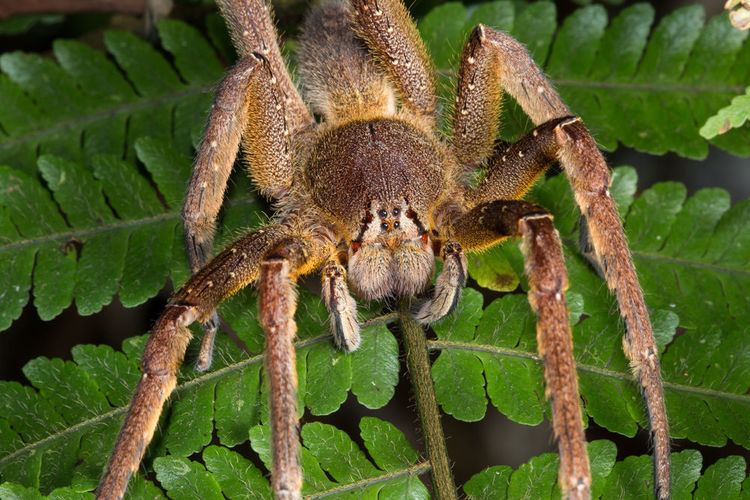
The Brazilian wandering spiders appear in Guinness World Records from 2010 as the world's most venomous spider. Guinness World Records states that although the Brazilian wandering spider venom is the most toxic, an effective antivenom is available and few fatalities occur.
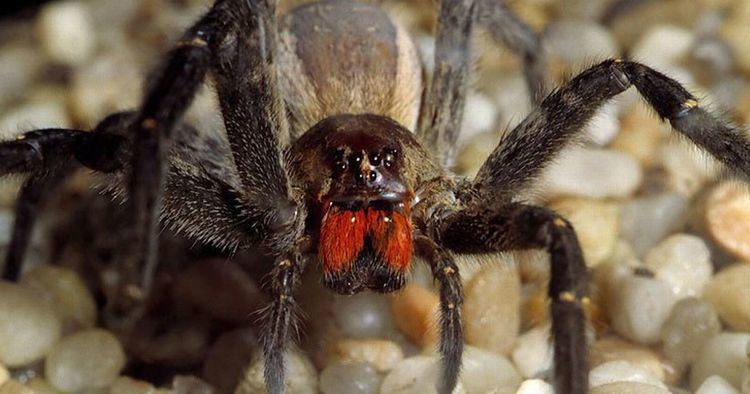
Phoneutria armadeira brazilian wandering spider atack defense
Description
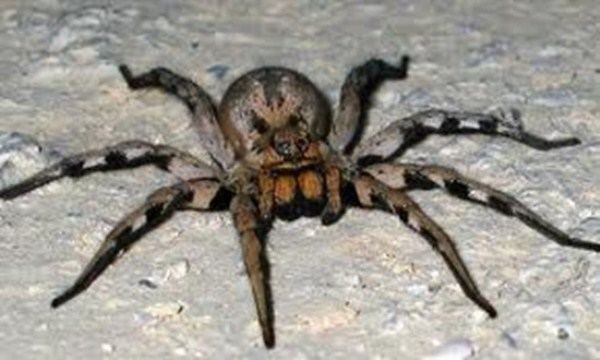
The spiders in the genus can grow to have a leg span of 13 to 15 cm (5.1 to 5.9 in). Their body length ranges from 17 to 48 mm (0.67 to 1.89 in). While some other araneomorph spiders have a longer leg span, the largest Phoneutria species have the longest body and the greatest body weight in this group. The genus is distinguished from other related genera such as Ctenus by the presence of dense prolateral scopulae (a dense brush of fine hairs) on the pedipalp tibiae and tarsi in both sexes. Phoneutria are easily confused with several other non-medically significant ctenids, especially Cupiennius, in which the recently described C. chiapanensis also has bright red hairs on the chelicerae. Additionally, some Phoneutria species lack red hairs on the chelicerae, making it an unreliable identification feature. The presence of a dark linear stripe or stripes on the frontal (dorsal) palps and presence of a single thin black line running anterior-posterior along the dorsal carapace may help identify Phoneutria. Other features are the strong ventral marking on the underside of the legs with contrasting dark mid-segments and lighter joints, and the pattern on the ventral (underside) of the abdomen with several rows of black dots, or an overall reddish colour.
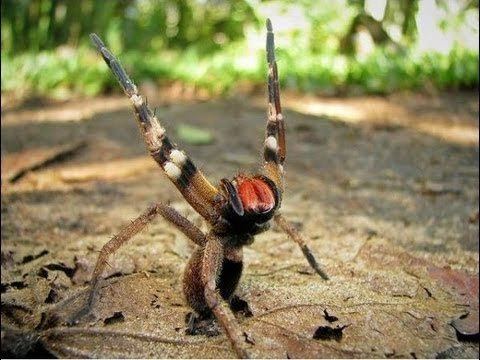
The characteristic defensive posture with frontal legs held high is an especially good indicator to confirm a specimen is Phoneutria, especially alongside correct colour patterns. During the defensive display the body is lifted up into an erect position, the first two pairs of legs are lifted high (revealing the conspicuous black/light-banded pattern on the leg underside), while the spider sways from side to side with hind legs in a cocked position.
Taxonomy
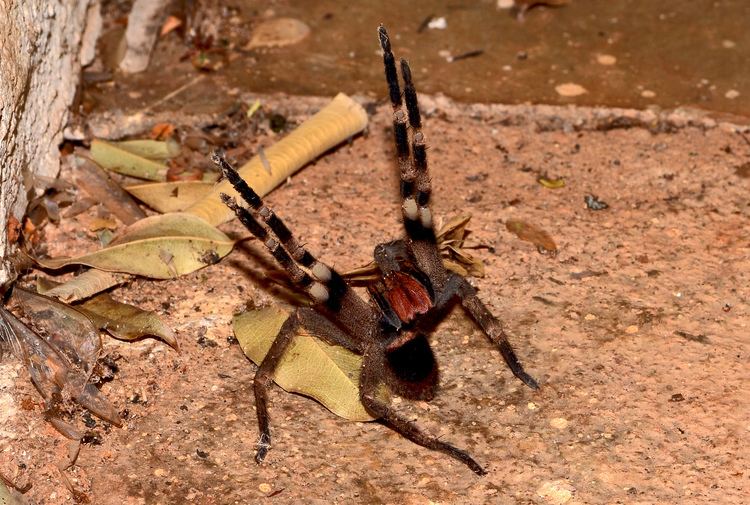
The genus Phoneutria was erected by Maximilian Perty in 1833. The genus name is from the Greek φονεύτρια, meaning "murderess". Perty placed two species in the genus: Phoneutria rufibarbis and Phoneutria fera. The former is treated as a "doubtful name" (nomen dubium); the latter as the type species of the genus.
Species
As of March 2016, the World Spider Catalog accepted the following species:
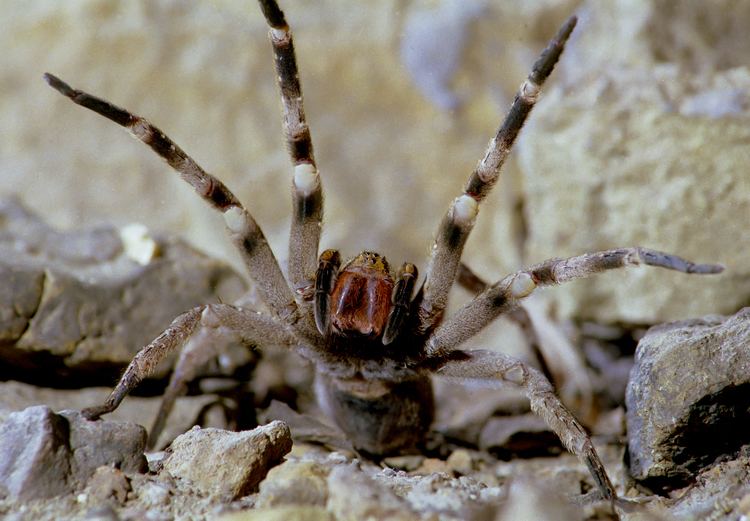
Behaviour
Wandering spiders are so-called because they wander the jungle floor at night, rather than residing in a lair or maintaining a web. During the day they hide inside termite mounds, under fallen logs and rocks, and in banana plants (hence the "banana spider" nickname) and bromeliads. P. nigriventer is known to hide in dark and moist places in or near human dwellings.
P. nigriventer mates during the dry season from April to June, which leads to frequent observations of the species during this time.
Distribution
Phoneutria are found in forests from Costa Rica, and throughout South America east of the Andes into northern Argentina, including Colombia, Venezuela, the Guianas, Ecuador, Peru, Bolivia, Brazil and Paraguay. Three species (P. reidyi, P. boliviensis and P. fera) are found in the Amazon region, one species (P. fera) is restricted to the Amazon, and one (P. boliviensis) ranges into Central America in Panama and Costa Rica. The remaining species are restricted to Atlantic Forest of Argentina, Paraguay and Brazil, including forest fragments in the Cerrado savanna. In Brazil, Phoneutria is only absent in the northeastern region north of Salvador, Bahia.
Phoneutria has been introduced to Chile and Uruguay.
Toxicity and prey
P. fera and P. nigriventer are widely considered the most venomous species of spider. Their venom contains a potent neurotoxin, known as PhTx3, which acts as a broad-spectrum calcium channel blocker that inhibits glutamate release, calcium uptake and also glutamate uptake in neural synapses. At deadly concentrations, this neurotoxin causes loss of muscle control and breathing problems, resulting in paralysis and eventual asphyxiation. In addition, the venom causes intense pain and inflammation following a bite due to an excitatory effect the venom has on the serotonin 5-HT4 receptors of sensory nerves. This sensory nerve stimulation causes a release of neuropeptides such as substance P which triggers inflammation and pain. The median lethal dose (LD50) of the venom is 134 µg/kg.
Aside from causing intense pain, the venom of the spider can also cause priapism in humans. Erections resulting from the bite are uncomfortable, can last for many hours and can lead to impotence. A component of the venom (Tx2-6) is being studied for use in erectile dysfunction treatments.
The amount of P. nigriventer venom necessary to kill a 20 g mouse has been shown to be only 6 μg intravenously and 134 μg subcutaneously as compared to 110 μg and 200 μg respectively for Latrodectus mactans (Southern black widow). This ranks Phoneutria venom among the most deadly spider venoms to mice. The Brazilian wandering spider's prey also includes crickets, katydids, mantids, and other larger animals, including tree frogs and lizards.
Danger to humans
The genus Phoneutria includes some of the relatively few species of spiders known to present a threat to humans. Danger to humans is not merely a question of toxicity, but requires the capacity to deliver the venom, a sufficient quantity of venom, a disposition that makes a bite likely and proximity to human habitation. The actual incidence of death or serious injury must also be considered.
Spider mouthparts are adapted to envenom very small prey; they are not well-adapted to attacking large mammals such as humans. Some experts believe that various spiders like Phoneutria can deliver a "dry" bite to purposely conserve their venom, as opposed to a more primitive spider like Atrax that usually delivers a full load. A study in March 2009 suggests that Phoneutria inject venom in approximately one-third of their bites, and only a small quantity in one-third of those cases. Another study similarly suggested that only 2.3 percent of bites (mainly in children) were serious enough to require antivenom. Other studies, as cited in the Wolfgang Bücherl studies, showed that the toxicity of Phoneutria venom was clearly more potent than both Latrodectus and Atrax. Research in this area is hindered by the difficulty of identifying particular species. Nevertheless, there are well-attested instances of death. In one case, a single spider killed two children in São Sebastião. The spider was positively identified as a Phoneutria by Wolfgang Bücherl.
Despite their reputation as the world's deadliest spiders, there are multiple studies that call into question their capacity for fatal human envenomation, though some of these are labeled with a level of uncertainty, as Phoneutria are often confused with other genera of ctenids, lycosids or other large labidognatha spiders. Of the eight described species, P. nigriventer and P. fera most frequently receive mention in mass-media publications. P. nigriventer is the species responsible for most cases of venom intoxication in Brazil because it is commonly found in highly populated areas of southeastern Brazil, such as the states of São Paulo, Minas Gerais, Rio de Janeiro and Espírito Santo. The species P. fera is native to the northern portion of South America in the Amazon of Brazil, Venezuela, Ecuador, Peru and the Guyanas.
These spiders' wandering nature is another reason they are considered so dangerous. In densely populated areas, Phoneutria species usually search for cover and dark places to hide during daytime, leading it to hide within houses, clothes, cars, boots, boxes and log piles, where they may bite if accidentally disturbed. These spiders acquired their other common name, "banana spider", because they are occasionally found within shipments of bananas, though the number of reports is exaggerated due to common misidentifications of unrelated spiders; a survey of spiders found in banana shipments revealed that only 7 of 135 spiders were Phoneutria species, and spiders such as Cupiennius had been misidentified by otherwise experienced arachnologists. Nonetheless, real cases have been documented: in 2005 a man was bitten in Bridgwater, England by a P. fera in a shipment of bananas; he was quickly treated but took a week to recover. In 2014 a family in London found and photographed a Brazilian wandering spider in a bunch of bananas delivered to their home.
